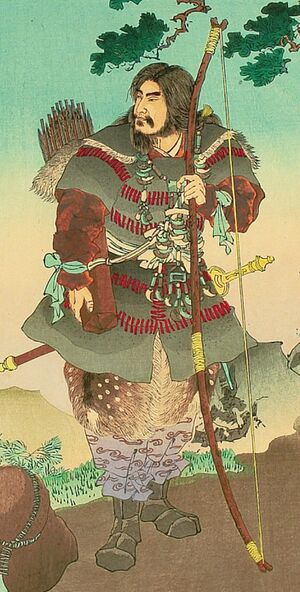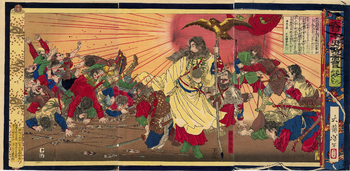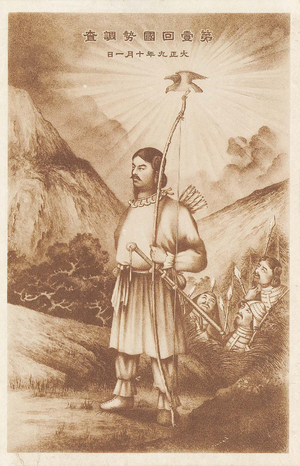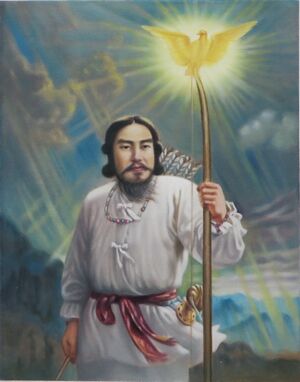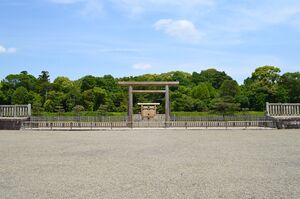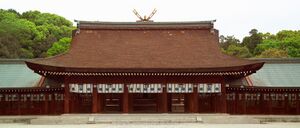الإمبراطور جيمّو
| ||||||||||||||||||||||||||||||||||
| ||||||||||||||||||||||||||||||||||
جِنمو-تِنو أو الإمبراطور جنمو (神武天皇) هو أول الأباطرة من الإنس حسب الأساطير اليابانية. ينحدر من آلهة الشمس "أماتيراسو نو أو مي كامي". خرج من صلبه الأباطرة الذين حكموا بلاد اليابان. جاء "جينمو" من "تاكاشيكو" إلى أرض "هيوغا"، و احتل كل الأراضي الواقعة شرق المنطقة ليتوج أخيراً في أرض "ياماتو".
ورد في كتاب "كوجيكي" (وقائع الأحداث القديمة) والذي يعود إلى عام 712 م: قامت آلهة الشمس "أماتيراسو أو مي كامي" بإرسال حفيدها نينيجي ليحكم الأرض. انتقلت إليه مقاليد الحكم من يد أحد أحفاد "أوكونينوتشي"، والذي كان من سلالة أحد إخوة الآلهة أماتيراسو: "سوسانووو نو ميكوتو". ثم أصبح أحد أحفاده وهو "جينمو" أول إمبراطور من الإنسيين -حسب الأسطورة دائما-. تعتبر الاساطير اليابانية القديمة تاريخ تتويجه هو تاريخ نشأة العالم، أو اليابان على الأقل، و أرخ الحدث في سنة 660 ق.م. إلا أنه لا توجد دلائل علمية على هذا الزعم.
الإمبراطور جيمّو (神武天皇, Jinmu-tennō) was the legendary first emperor of Japan according to the Nihon Shoki and Kojiki.[2] His ascension is traditionally dated as 660 BC.[6][7] In Japanese mythology, he was a descendant of the sun goddess Amaterasu, through her grandson Ninigi, as well as a descendant of the storm god Susanoo. He launched a military expedition from Hyūga near the Seto Inland Sea, captured Yamato, and established this as his center of power. In modern Japan, Emperor Jimmu's legendary accession is marked as National Foundation Day on February 11.[8]
ولا يوجد دليل على تواجد جيمّو ويعتبره معظم الدارسين الحديثين شخصية أسطورية.
. . . . . . . . . . . . . . . . . . . . . . . . . . . . . . . . . . . . . . . . . . . . . . . . . . . . . . . . . . . . . . . . . . . . . . . . . . . . . . . . . . . . . . . . . . . . . . . . . . . . . . . . . . . . . . . . . . . . . . . . . . . . . . . . . . . . . . . . . . . . . . . . . . . . . . . . . . . . . . . . . . . . . . . .
الاسم واللقب
Jimmu is recorded as Japan's first ruler in two early chronicles, Nihon Shoki (721) and Kojiki (712).[2] Nihon Shoki gives the dates of his reign as 660–585 BC.[2] In the reign of Emperor Kanmu (737–806),[4] the eighth-century scholar Ōmi no Mifune retroactively designated rulers before Emperor Ōjin as tennō (天皇, "heavenly sovereign"), a Japanese pendant to the Chinese imperial title Tiān-dì (天帝), and gave several of them including Jimmu their posthumous names. Prior to this time, these rulers had been known as Sumera no mikoto/Ōkimi. This practice had begun under Empress Suiko, and took root after the Taika Reforms with the ascendancy of the Nakatomi clan.[9]
Both the Kojiki and the Nihon Shoki give Jimmu's name as Kamu-yamato Iware-biko no Mikoto (神倭伊波礼琵古命) or Kamu-yamato Iware-biko no Sumeramikoto (神日本磐余彦天皇).[10] Iware indicates a toponym (an old place name in the Nara region) whose precise purport is unclear.[11] '-no-Mikoto' is an honorific, indicating divinity, nobility, or royalty.
Among his other names were: Wakamikenu no Mikoto (若御毛沼命), Kamu-yamato Iware-biko hohodemi no Mikoto (神日本磐余彦火火出見尊) and Hikohohodemi (彦火火出見).
The Imperial House of Japan traditionally based its claim to the throne on its putative descent from the sun-goddess Amaterasu via Jimmu's great-grandfather Ninigi.[12]
السردية الأسطورية
In Japanese mythology, the Age of the Gods is the period before Jimmu's accession.[13]
The story of Jimmu seems to rework legends associated with the Ōtomo clan (大伴氏), and its function was to establish that clan's links to the ruling family, just as those of Suijin arguably reflect Mononobe tales and the legends in Ōjin's chronicles seem to derive from Soga clan traditions.[14] Jimmu figures as a direct descendant of the sun goddess, Amaterasu via the side of his father, Ugayafukiaezu. Amaterasu had a son called Ame no Oshihomimi no Mikoto and through him a grandson named Ninigi-no-Mikoto. She sent her grandson to the Japanese islands where he eventually married Konohana-Sakuya-hime. Among their three sons was Hikohohodemi no Mikoto, also called Yamasachi-hiko, who married Toyotama-hime. She was the daughter of Ryūjin, the Japanese sea god. They had a single son called Hikonagisa Takeugaya Fukiaezu no Mikoto. The boy was abandoned by his parents at birth and consequently raised by Tamayori-hime, his mother's younger sister. They eventually married and had four sons. The last of these, Hikohohodemi, became Emperor Jimmu.[15]
الهجرة

According to the chronicles Kojiki and Nihon Shoki, Jimmu's brothers Itsuse no Mikoto, Inahi no Mikoto, and Mikeiri no Mikoto were born in Takachiho, the southern part of Kyūshū in modern-day Miyazaki Prefecture. They moved eastward to find a location more appropriate for administering the entire country. Jimmu's older brother, Itsuse no Mikoto, originally led the migration, and led the clan eastward through the Seto Inland Sea with the assistance of local chieftain ja (Saonetsuhiko). As they reached Naniwa (modern-day Osaka), they encountered another local chieftain, Nagasunehiko ("the long-legged man"), and Itsuse was killed in the ensuing battle. Jimmu realized that they had been defeated because they battled eastward against the sun, so he decided to land on the east side of Kii Peninsula and to battle westward. They reached Kumano, and, with the guidance of a three-legged crow, Yatagarasu ("eight-span crow"), they moved to Yamato. There, they once again battled Nagasunehiko and were victorious. The record in the Nihon Shoki of Emperor Jimmu states that his armed forces defeated a group of Emishi (蝦夷, 'shrimp barbarians') before his enthronement.[16] The Emishi were an ethnic group who lived in Honshu, particularly the Tōhoku region.
In Yamato, Nigihayahi, who also claimed descent from the Takamagahara gods, was protected by Nagasunehiko. However, when Nigihayahi met Jimmu, he accepted Jimmu's legitimacy. At this point, Jimmu is said to have ascended to the throne of Japan. Upon scaling a Nara mountain to survey the Seto Inland Sea he now controlled, Jimmu remarked that it was shaped like the "heart" rings made by mating dragonflies, archaically akitsu 秋津.[17] A mosquito then tried to steal Jimmu's royal blood but since Jimmu was a god incarnate Emperor, akitsumikami (現御神), a dragonfly killed the mosquito. Japan thus received its classical name the Dragonfly Islands, akitsushima (秋津島).
According to the Kojiki, Jimmu died when he was 126 years old. The Emperor's posthumous name literally means "divine might" or "god-warrior". It is generally thought that Jimmu's name and character evolved into their present shape just before[18] the time in which legends about the origins of the Yamato dynasty were chronicled in the Kojiki.[4] There are accounts written earlier than either Kojiki and Nihon Shoki that present an alternative version of the story. According to these accounts, Jimmu's dynasty was supplanted by that of Ōjin, whose dynasty was supplanted by that of Keitai.[19] The Kojiki and the Nihon Shoki then combined these three legendary dynasties into one long and continuous genealogy.
The traditional site of Jimmu's grave is near Mount Unebi in Kashihara, Nara Prefecture.[20]
تبجيل عهد الإمبراطور
Veneration of Jimmu was a central component of the imperial cult that formed following the Meiji Restoration.[21] In 1873, a holiday called Kigensetsu was established on February 11.[22] The holiday commemorated the anniversary of Jimmu's ascension to the throne 2,532 years earlier.[23] After World War II, the holiday was criticized as too closely associated with the "emperor system."[22] It was suspended from 1948 to 1966, but later reinstated as National Foundation Day.[22][24]
Between 1873 and 1945 an imperial envoy sent offerings every year to the supposed site of Jimmu's tomb.[25] In 1890 Kashihara Shrine was established nearby, on the spot where Jimmu was said to have ascended to the throne.[26]
Before and during World War II, expansionist propaganda made frequent use of the phrase hakkō ichiu, a term coined by Tanaka Chigaku based on a passage in the Nihon Shoki discussing Emperor Jimmu.[27] Some media incorrectly attributed the phrase to Emperor Jimmu.[28] For the 1940 Kigensetsu celebration, marking the supposed 2,600th anniversary of Jimmu's enthronement, the Peace Tower[29] was constructed in Miyazaki.[30]
The same year numerous stone monuments relating to key events in Jimmu's life were erected around Japan. The sites at which these monuments were erected are known as Emperor Jimmu Sacred Historical Sites.[31]
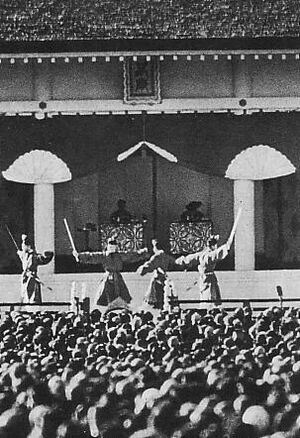
In 1940 Japan celebrated the 2600th anniversary of Jimmu's ascension and built a monument to Hakkō ichiu despite the fact that all historians knew Jimmu was a mythical figure. In 1941 the Japanese government charged the one historian who dared to challenge Jimmu's existence publicly, Tsuda Sōkichi.[32]
التاريخانية
Since after World War II, when the prohibition on questioning the Kojiki and the Nihongi was lifted, documentary research in China and archaeological research in Japan has undermined much of the information in both the Kojiki and Nihon Shoki.[33] No evidence has been found for Jimmu’s existence, except the mention in the Nihon Shoki and Kojiki.[34][2][35] Today most modern scholars agree that the traditional founding of the Yamato dynasty in 660 BC is a myth and that Jimmu is legendary.[36]Emperor Sujin's historicity is considered possible by historians, while Emperor Kinmei is the first verifiable historical figure in the Yamato lineage.[37][38]
The dates of Jimmu reigning from 660 BC to 585 BC are improbable.[39] According to Dr. Lu, the year 660 BC was probably selected by the writers of Nihon Shoki to put the founding of Japan on a kanototori year.[40]
However, the stories of Jimmu may reflect real events of the mid to late Yayoi period.[41] According to historian Peter Wetzler, Jimmu's conquest of Osaka and Nara may reflect an actual event. Still, the dates and many of the details are fictitious.[42] Historian Kenneth G. Henshall stated that Jimmu's conquest may also reflect a time when the Yayoi people from continental Asia immigrated in masses starting from Kyushu and moving eastward during the Yayoi period.[43]
Some scholars suggest that there may have been a real person behind Jimmu. He could have been a local ruler who conquered the area near Kashihara after 62 BC.[33] Some scholars believe he was present in Miyazaki during the first century BC while others say he was there during the third or fourth century AD. Nevertheless, there is a high probability that there was a powerful dynasty in the vicinity of Miyazaki Prefecture during the Kofun period.[33]
According to Louis Frédéric, he may have been a fusion of Suijin and Kentai.[44] The Japanese historian Ino Okifu identifies Emperor Jimmu with the Chinese alchemist and explorer Xu Fu, a hypothesis supported by certain traditions in Japan and regarded as possible by some modern scholars.[45][46] The Yayoi period, during which significant changes in Japanese metallurgy and pottery occurred, started around the time of his supposed arrival.[47][48] However, the legend of Xu Fu's voyage also has numerous inconsistencies with the linguistic and anthropological history of Japan.[46]
. . . . . . . . . . . . . . . . . . . . . . . . . . . . . . . . . . . . . . . . . . . . . . . . . . . . . . . . . . . . . . . . . . . . . . . . . . . . . . . . . . . . . . . . . . . . . . . . . . . . . . . . . . . . . . . . . . . . . . . . . . . . . . . . . . . . . . . . . . . . . . . . . . . . . . . . . . . . . . . . . . . . . . . .
Consorts and children
- Consort: Ahiratsu-hime (吾平津媛), Hosuseri's (Ninigi-no-Mikoto's son) daughter
- First son: Prince Tagishimimi (手研耳命)
- Son: Prince Kisumimi (岐須美美命)
- Daughter: Princess Misaki (神武天皇)
- Empress: Himetataraisuzu-hime (媛蹈鞴五十鈴媛), Kotoshironushi's daughter
- Son: Prince Hikoyai no mikoto (日子八井命)
- Second son: Prince Kamuyaimimi no mikoto (神八井耳命, d.577 BC)
- Third son: Prince Kamununakawamimi (神渟名川耳尊), later Emperor Suizei
Family tree
قالب:A genealogical tree based on the Kojiki قالب:Generations of Jimmu
See also
- Modern system of ranked Shinto shrines
- Japanese imperial year
- National Foundation Day
- Jōmon period
- Yayoi period
- Emishi people
- Order of the Golden Kite
- King Arthur, a legendary figure from Britain who founded the country similar to Emperor Jimmu
Notes
References
- ^ Clements, Jonathan (2017). "Chapter 5". A Brief History of Japan: Samurai, Shogun and Zen: The Extraordinary Story of the Land of the Rising Sun (in الإنجليزية). Tuttle Publishing. ISBN 978-1-4629-1934-5.
- ^ أ ب ت ث ج Campbell, Allen; Nobel, David S (1993). "Jimmu Emperor". Japan: An Illustrated Encyclopedia. Kodansha. p. 1186. ISBN 406205938X.
- ^ "Genealogy of the Emperors of Japan" (Archive), Imperial Household Agency, 2011.
- ^ أ ب ت Aston 1896, pp. 109–137.
- ^ Chamberlain 1919, p. 188.
- ^ Kelly, Charles F. "Kofun Culture", Japanese Archaeology. April 27, 2009.
- ^ * Kitagawa, Joseph (1987). On Understanding Japanese Religion, p. 145, في كتب گوگل: "emphasis on the undisrupted chronological continuity from myths to legends and from legends to history, it is difficult to determine where one ends and the next begins. At any rate, the first ten legendary emperors are clearly not reliable historical records."
- Boleslaw Szczesniak, "The Sumu-Sanu Myth: Notes and Remarks on the Jimmu Tenno Myth", in Monumenta Nipponica, Vol. 10, No. 1/2 (Winter 1954), pp. 107–26. DOI:10.2307/2382794. JSTOR 2382794.
- ^ Trevor, Malcolm (2001). Japan: Restless Competitor: The Pursuit of Economic Nationalism. Psychology Press. p. 79. ISBN 978-1-903350-02-7.
- ^ Jacques H. Kamstra Encounter Or Syncretism: The Initial Growth of Japanese Buddhism, Brill 1967 pp. 65–67.
- ^ 神倭伊波礼琵古命, OJ pronunciation: Kamu-Yamatö-ipare-biko (nö-mikötö) Donald Philippi, tr. Kojiki, University of Tokyo Press, 1969 p. 488
- ^ Japanese Wikipedia Iware
- ^ Bob Tadashi Wakabayashi, [Japanese Loyalism Reconstrued: Yamagata Daini's Ryūshi Shinron of 1759], University of Hawai'i Press, 1995 pp. 106–107.
- ^ Nussbaum, "Jindai" at p. 421, p. 421, في كتب گوگل.
- ^ Jacques H. Kamstra, Encounter Or Syncretism: The Initial Growth of Japanese Buddhism, Brill 1967 pp. 69–70.
- ^ Nussbaum, "Chijin-godai" at p. 111, p. 111, في كتب گوگل.
- ^ 朝廷軍の侵略に抵抗 (in اليابانية). Iwate Nippo. September 24, 2004. Archived from the original on March 3, 2016. Retrieved March 1, 2011.
- ^ メンテナンス中
- ^ Kennedy, Malcolm D. A History of Japan. London. Weidenfeld & Nicolson, 1963.
- ^ Ooms, Herman. Imperial Politics and Symbolics in Ancient Japan: the Tenmu Dynasty, 650–800. Honolulu: University of Hawai'i Press, 2009
- ^ Imperial Household Agency (Kunaichō): 神武天皇 (1); retrieved August 22, 2013.
- ^ "Nationalism and History in Contemporary Japan". Retrieved February 11, 2017.
- ^ أ ب ت "Kigensetsu Controversy", Japan: An Illustrated Encyclopedia (1993), Kodansha. ISBN 978-4069310980.
- ^ Britannica Kokusai Dai-Hyakkajiten article on "Kigensetsu".
- ^ "Founding Day rekindles annual debate". The Japan Times. February 11, 1998. Retrieved May 24, 2014.
- ^ Martin, Peter. (1997). The Chrysanthemum Throne: A History of the Emperors of Japan, pp. 18–20.
- ^ Kashihara City website tourism page on "Kashihara Jingū".
- ^ Britannica Kokusai Dai-Hyakkajiten article on "Hakkō ichiu".
- ^ Dower, John W., War Without Mercy: Race & Power in the Pacific War, faber and faber, 1993 p. 223.
- ^ Peace Tower (平和の塔, Heiwa no Tō, originally called the "Hakkō Ichiu Tower" 八紘一宇の塔 Hakkō Ichiu no Tō or the "Pillar of Heaven and Earth" 八紘之基柱 Ametsuchi no Motohashira)
- ^ Motomura, Hiroshi (February 10, 2015). "Miyazaki's controversial Peace Tower continues to cause unease". The Japan Times (in الإنجليزية الأمريكية). ISSN 0447-5763. Retrieved February 9, 2018.
- ^ Ruoff, Kenneth J. (2014). Imperial Japan at Its Zenith: The Wartime Celebration of the Empire's 2,600th Anniversary. Cornell University Press. p. 41. ISBN 978-0801471827. Retrieved February 10, 2018.
- ^ Sundberg, Steve (October 22, 2018). "2600th Anniversary of the Founding of Japan, 1940". Old Tokyo.
- ^ أ ب ت Ring, Trudy; Salkin, Robert M.; Schellinger, Paul E.; Boda, Sharon La; Watson, Noelle; Hudson, Christopher; Hast, Adele (1994). International Dictionary of Historic Places: Asia and Oceania (in الإنجليزية). Taylor & Francis. ISBN 978-1-884964-04-6.
- ^ Ruoff, Kenneth J. (2021). Japan's Imperial House in the Postwar Era, 1945–2019. Brill. p. 171. ISBN 978-1-68417-616-8.
- ^ Hoye, Timothy (1999). Japanese Politics: Fixed and Floating Worlds. p. 78.
- ^ Shillony, Ben-Ami (2008). The Emperors of Modern Japan. Brill. ISBN 978-90-04-16822-0.
- ^ Hoye, Timothy (1999). Japanese politics : fixed and floating worlds (1st ed.). Upper Saddle River, N.J.: Prentice Hall. p. 78. ISBN 0-13-271289-X. OCLC 38438419.
- ^ Yoshida, Reiji (March 27, 2007). "Life in the Cloudy Imperial Fishbowl". The Japan Times. Archived from the original on 27 July 2020. Retrieved 22 August 2013.
- ^ Henshall, Kenneth (2013). Historical Dictionary of Japan to 1945. Scarecrow Press. p. 99. ISBN 978-0-8108-7872-3.
- ^ Lu, David J. (2015). Japan: A Documentary History. Vol. 1: The Dawn of History to the Late Eighteenth Century: A Documentary History. Routledge. p. 9. ISBN 978-1-317-46712-0.
- ^ Brown, Delmer M.; Hall, John Whitney; McCullough, William H.; Jansen, Marius B.; Shively, Donald H.; Yamamura, Kozo; Duus, Peter (1988). The Cambridge History of Japan. Cambridge University Press. p. 102. ISBN 978-0-521-22352-2.
- ^ Wetzler, Peter (1998). Hirohito and War: Imperial Tradition and Military Decision Making in Prewar Japan. University of Hawaii Press. pp. 101–102. ISBN 978-0-8248-6285-5.
- ^ Henshall, Kenneth (2013). Historical Dictionary of Japan to 1945. Scarecrow Press. p. 100. ISBN 978-0-8108-7872-3.
- ^ Louis-Frédéric (2002). Japan Encyclopedia (in الإنجليزية). Harvard University Press. pp. 420–421. ISBN 978-0-674-01753-5.
- ^ Liu, Hong. The Chinese Overseas: Routledge Library of Modern China. Taylor & Francis (2006). ISBN 0-415-33859-X.
- ^ أ ب Major, John S. (1978). "Christy G. Turner II, 'Dental Evidence on the Origins of the Ainu and Japanese.' Science 193 (3 091976):911–13. Marvin J. Allison, 'Paleopathology in Peru'. Natural History 88.2 (2, 1978):74–82". Early China. 4: 78–79. doi:10.1017/S0362502800005988. S2CID 163764133.
- ^ Lee, Khoon Choy Lee. Choy, Lee K. (1995). Japan – between Myth and Reality: Between Myth and Reality. World Scientific publishing. ISBN 981-02-1865-6.
- ^ Face to Face. The Transcendence of the Arts in China and Beyond – Historical Perspectives (1st ed.). Lisbon, Portugal: Faculdade de Belas Artes. 2014. pp. 17–18. ISBN 978-989830049-2.
Bibliography
- Aston, William G. (1896). Nihongi: Chronicles of Japan from the Earliest Times to A.D. 697 [Nihon Shoki]. London: The Japan Society of the UK. ISBN 978-0524053478.
- Brown, Delmer M. and Ichirō Ishida, eds. (1979). Gukanshō: The Future and the Past. Berkeley: University of California Press. ISBN 978-0-520-03460-0; OCLC 251325323
- Brownlee, John S. (1997). Japanese Historians and the National Myths, 1600–1945: The Age of the Gods. Vancouver: University of British Columbia Press. ISBN 0-7748-0645-1
- Chamberlain, Basil Hall (1919). "The Kojiki". Evinity Publishing. OCLC 1882339.
- Earhart, David C. (2007). Certain Victory: Images of World War II in the Japanese Media. Armonk, New York: M. E. Sharpe. ISBN 978-0-7656-1776-7
- Kitagawa, Joseph Mitsuo (1987). On Understanding Japanese Religion. Princeton: Princeton University Press. ISBN 978-0-69107313-2, 978-0-69110229-0; OCLC 15630317
- Nussbaum, Louis Frédéric (2002). Japan Encyclopedia. Harvard University Press. ISBN 978-0674017535.
- Ponsonby-Fane, Richard Arthur Brabazon (1959). The Imperial House of Japan. Kyoto: Ponsonby Memorial Society. OCLC 194887
- Titsingh, Isaac (1834). Annales des empereurs du Japon [Nihon Ōdai Ichiran] (in French). Paris: Royal Asiatic Society of Great Britain and Ireland. OCLC 5850691.
{{cite book}}: CS1 maint: unrecognized language (link) - Varley, H. Paul (1980). A Chronicle of Gods and Sovereigns: Jinnō Shōtōki of Kitabatake Chikafusa [Jinnō Shōtōki]. New York: Columbia University Press. ISBN 978-0231049405. OCLC 59145842.
External links
- A more detailed profile of Jimmu (archived April 2011)
- A detailed summary of Jimmu's descent legend (archived July 2014)
- "(帝紀) Family tree of Japanese monarchs"(2024)
الإمبراطور جيمّو
| ||
| ألقاب ملكية | ||
|---|---|---|
| منصب مستحدث | Emperor of Japan | تبعه Emperor Suizei |
- CS1 uses اليابانية-language script (ja)
- CS1 اليابانية-language sources (ja)
- CS1 الإنجليزية الأمريكية-language sources (en-us)
- Short description with empty Wikidata description
- Articles with hatnote templates targeting a nonexistent page
- Pages with empty portal template
- Legendary emperors of Japan
- Longevity myths
- People of Jōmon-period Japan
- Founding monarchs
- Legendary progenitors
- Legendary monarchs
